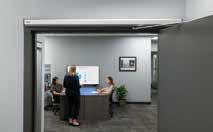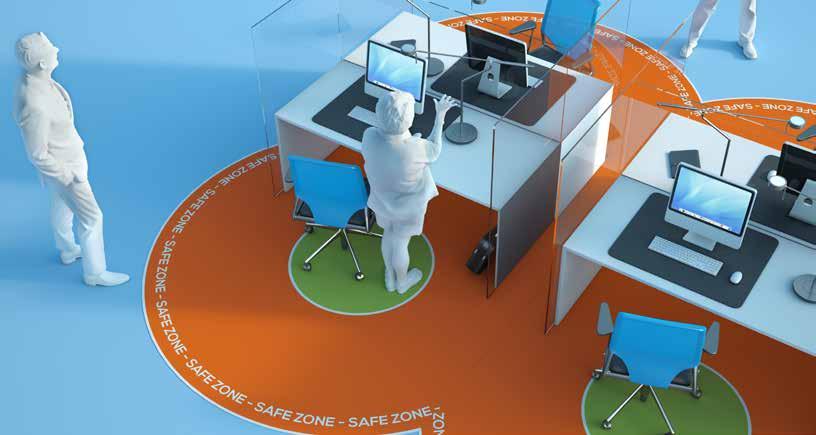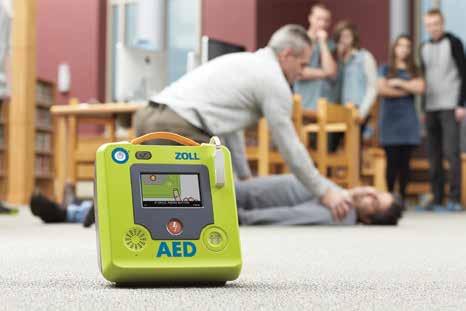
16 minute read
RISE OF THE HYBRID OFFICE
from CFMD December 2020
by MediaEdge
BY ANNIE BERGERON
SO WHY DO PEOPLE WANT TO RETURN TO THE OFFICE?
While the Gensler U.S. Work From Home Survey 2020 shows with real data that most people want to return to the office the majority of their week, employees also want a future in which they have more choice and agency than they did before the pandemic. Despite declarations from some that full-time work-fromhome arrangements will remain after COVID-19 restrictions are lifted, there are many indicators that permanent work-from-home arrangements are not sustainable for culture, innovation and talent development, nor is it a replacement for the speed of trust and collaboration that’s built through face-to-face work. Collaborative work moves forward at the speed of trust that is built into our relationships. Research shows that the top reason people want to come back to the office is the people. In fact, 54 per cent of respondents from Gensler’s survey say their colleagues are what they miss the most about the office. While workfrom-home has made it possible to keep momentum for most work functions, it is not a perfect substitute for work that’s done together.
This all begs for a change in how the workplace functions. As we start making the transition back to the office, and as we resettle more permanently, the kinds of collaboration, teamwork and meetings that make up our daily work lives will need to embrace a new “hybrid reality” — a blend of analog and virtual participation that could redefine how we
Instead of a step back in time, this era will be a catalyst for positive change: we will be moving forward to a new place, modified in strategic ways, incorporating new practices, new protocols and new technologies.
The future of work will integrate the lessons learned from our extended time working from home, an experience that many businesses have transitioned to with minimal friction, and free us from preconceived notions about place and productivity.
accomplish work going forward.
WHAT WILL THE NEW HYBRID WORKPLACE LOOK LIKE?
While empty in the short term, a return to the office demands that we create an ecosystem of workplace experiences that employees cannot get at home in order for a hybrid future to be successful.
Productivity myths around working from home have been thoroughly debunked. In fact, a report from NordVPN (March 2020) revealed that Canadians increased their average workday by 2 hours since the onset of the pandemic. We know that focused work can happen successfully at home.
Remote work has also made it clear which spaces best facilitate collaboration, focus, learning and socializing. What’s emerging is a hybrid future, with people working and collaborating from home and from the office. When people return to the office, 60 per cent reported they expect more choices in how to work, including increased opportunities to work remotely.
Right-sizing spaces for hybrid work behaviours requires the office of the future to align meeting spaces to the types of collaboration that occur inoffice as opposed to virtually, for example; in the future, generative ideation meetings will be prioritized as in-person events, whereas evaluative decision-making meetings will happen virtually. Built on the idea that with fewer employees physically present on any given day, offices can offer more flexibility of layout and management.
This will require an enhanced technology infrastructure to support seamless virtual connection opportunities in the physical workplace, ensuring the collaboration experience is consistent for both in-person and virtual participants.
Other technology interventions that will affect facilities’ teams and building managers will be intelligent rooms that will enable staff to manage how they use shared spaces through smartphone apps. Gathering spaces, meeting rooms, phone rooms and focus hubs will be catalogued and available for reservation “The hybrid office will have at its heart a planning principle based on people rotating in and out of the office, with flexible schedules they have more control over than ever.”
at the touch of a screen. Space booking will be enhanced by allowing employees to order catering, adjust AV, lighting and temperature all from the same management system. Guests will be able to check into the building via the same system and be screened, then given the necessary directions to the meeting room or workspace.
A natural consequence of smart offices is that they will enable service teams to either hold slots for cleaning or use the available data to identify high-traffic areas to focus their cleaning efforts. Maintenance teams will also use the data from meeting room booking systems in order to plan cleaning when areas have been vacated.
Ultimately, the hybrid office will have at its heart a planning principle based on people rotating in and out of the office, with flexible schedules they have more control over than ever. Its biggest draw will be more varied workspaces for collaboration, a refuge from a distraction-filled home and, more importantly, a place for human connection. | CFM&D
Annie Bergeron is the design director at Gensler
ENTER A NEW ERA Take your doors from manual to modern with the Ditec HA7

SHOW GERMS
THE DOOR
Upgrade your manual door to touch-free Limits contact with germs on door handles Perfect for bathroom, o ce, and assisted living facility doors
MEET THE
DITEC HA7 APP


Makes setup a breeze Ability to control and customize functions Available in Google Play and Apple App stores
SLEEK
AND SLIM

Sleek aesthetics built to blend in Perfect solution for limited overhead space Push and pull confi gurations Clear or dark bronze fi nishes available
BY LIBBY FERIN
SELECTING A WORKSTATION IN A POST-PANDEMIC WORLD
COVID-19 has upended the traditional workplace, creating a unique set of challenges for facility managers and designers. One invaluable lesson is to seek out workplace solutions that meet multiple needs. Another is to make sure those solutions empower workers to work how they want in order to be most productive and happy. With this in mind, here are three considerations for selecting and specifying the right workstation for today.

ALLOW FOR SAFETY, PERSONAL SPACE AND COLLABORATION
Designing a workplace today is a balancing act. It must effectively account for social distancing requirements while also recognizing the need for interaction and collaboration. Zoom and videoconferencing can keep teams connected and on-task. That said, nothing can replace the creativity, innovation and organizational culture that springs from in-person interactions. Providing spaces that allow for that activity is inherently important.
For instance, reimagine the traditional conference room. Removing the big executive table and replacing it with
mobile, individual tables easily achieves social distancing and enables teammates to fully connect with one another in an in-person setting.
In environments where workers sit side-by-side, dividers are a great solution to increase worker confidence in an open office. For ultimate flexibility and safety, portable slide dividers can be an excellent option. These products easily slip on or off a desk surface, offering privacy and protection between coworkers when needed. Lightweight and portable, they can be carried to other office spaces, such as conference rooms, break rooms or eating areas. This is a simple solution when people need to come together in a common area, but also adhere to safety measures.
Another consideration: Mobile, single-person workstations. This solution enables workers to “grab and go,” – taking their desks where they need it, when they need it. Workers can easily move to a safe or isolated area, creating separation from their co-workers.
ALLOW FOR STANDARD AND CUSTOMIZATION OPTIONS
Standard workstation products still have their place in today’s modern office. But safety modifications are now essential for providing enhanced confidence for workers. For workers consigned to a fixed workstation and unable to choose their own work location, it’s important to provide them with the power of choice. Workers who have the ability to choose or customize their workstations the way they want are often happier and more productive. An example of a customized option is a height-adjustable table and an adjustable monitor arm. This dual solution provides better ergonomics. In fact, research shows that standing and changing posture throughout the day brings multiple health benefits, including increased cognitive stimulation.
Many height-adjustable tables have memory-setting features and are available in custom sizes and finish options. These customization features can provide a greater level of personalization and empowerment. Accessory items, such as ambient lighting and personal storage units,

can also be added to further help workers utilize the products that work best for them.
Creating personal workspace “enclaves” or “phone booths” is another option. These semi-private, individual spaces can be an exceptional alternative for workers who need a place to retreat from their assigned stationary workstation for either safety or uninterrupted work.
ALLOW FOR INDIVIDUAL HOME WORK ENVIRONMENT NEEDS
Employers have had to adapt to their employees working from home during the pandemic. Numerous organizations are now embracing a flexible workforce schedule to manage the number of employees in the office at one time. Additionally, many employees are requesting to work on a hybrid schedule – they want a balance between working at home and having a presence in the office.
Employers seeking to accommodate this new reality need to equip their staff with the appropriate workplace resources to support and optimize their work. Providing employees with a variety of workstation options that best suit their unique, individual home-based workplace environment is key. For example, a worker in an apartment with limited space might benefit from a mobile, highly durable table. Alternatively, a worker with a dedicated home office, which may have ample space available, might benefit from a slightly larger heightadjustable desk. Allowing at-home workers to choose what works best for them in their own home is ideal – whether that’s a mobile, adaptable or fixed workplace solution. | CFM&D
Libby Ferin is the vice-president of marketing for Innovative Ergonomic Solutions, a collection of workspace furnishings companies. Committed to growth and excellence, IES is making a lasting impact on the global landscape of ergonomics. More information is available at SISErgo.com and HATContract.com.

Knowledge looks great on you
High level decision makers and infl uencers depend on us to be their trusted information source within the Canadian Real Estate Management Industry
SERVING THE FACILITY CLEANING & MAINTENANCE INDUSTRY
JUNE 2019
� NUISANCE ANIMALS:
KEEPING RACCOONS AT BAY � GET IN LINE WITH
ONLINE TRAINING � GREEN ROOFS: SUSTAINABLE
SHELTERS FOR PESTS?
ON THE LEVEL
PART OF THE
Stephanie Toomey’s honest approach to business key to building long-lasting employee, client relationships
PART OF THE FOR BUILDING OWNERS, ASSET AND PROPERTY MANAGERS
PART OF THE
PART OF THE VOL. 34 NO. 2 • JUNE 2019
PRODUCTIVE ENERGY Sustainable Conductors for Cost Savings
Publication Agreement #40063056
CANADA $15.00
PART OF THE
PART OF THE
RETROFIT INVESTMENT POLICY UNCERTAINTY PASSIVE HOUSE APPLICATIONS ESG GUIDANCE ELECTRICITY COST ALLOCATION INCENTIVE STRATEGIES
PART OF THE
PART OF THE 8 201 R BE M SEPTE
OUTSOURCING COMPACT PORTFOLIOS
BANK OF CANADA’S HQ MODERNIZATION MEETS PRESERVATION
HUMANCENTRIC
LIGHTING
CO-GENERATION ATCARLETONU
Canadian Publications Mail Product Sales Agreement No. 40063056 PART OF THE
P A R T O F T H E
FOCUS ON LIGHTING
Canada’s Most Widely Read Condominium Magazine September 2019 • Vol. 34 #4
VOLUME 16 / NUMBER 4 / SEPTEMBER/OCTOBER 2019 SEPTEMBER/OCTOBER 2019 Apartment CANADIAN
COMMON AREA RENOS What to consider when refreshing public spaces
PM#40063056 +Ask the Expert: Budget-friendly renovations
Upgrading the resident experience
PART OF THE
PART OF THE
FORWARD THINKING FORWARD THINKING
HOUSING SOLUTIONS FOR A BETTER TOMORROW
PART OF THE
PART OF THE
PM#40063056 plus
Q3 SALES ACTIVITY
CO-LIVING CREDIT TRENDS
Leverage our award-winning insight
Aparpar CANADIAN VOLUME 16 / NUMBER 2 / JUNE 2019OLUME 16 / NUMBER 2 / JUNE 2019tment
June 2018 • Vol. 33 #2
WHO'S WHO 2019
SPONSORED BY: FOR BUILDING OWNERS, ASSET AND PROPERTY MANAGERS
BALANCING THE BOOKS Will new cost pressures force corporations to revise their budgets this year?
PART OF THE
P A R T O F T H E
6 5 0 3 6 00 4 # M P THE DIGITAL EDGETHE DIGITAL EDGEAL EDG AL EDG VOL. 34 NO. 3 • AUGUST 2019 PART OF THE plus MARKET UPDATE INNOVATIVE WAYS TO FILL SUITES FASTERNOVATIVE WAYS TO FILL SUITES COMPETITIVE STANCE
INSURING YOUR PROPERTY INCLUSIONARY ZONING
Repositioning Challenges and Opportunities
P A R T O F T H E
Publication Ag r eement #40063056
0 A $15.0 D A N CA
PART OF THE
P A R T O F T H E
TECH SECTOR SPINOFFS EVOLVING RETAIL APPETITE OPERATIONAL SUPPORT TALENT ENTICEMENT TACTICS PROPERTY TAX DEFINING DEMAND Occupiers’ liability: A board meeting gone wrong
Anyone who has ever been to BY DAVID ELMALEH a board meeting (or a partners, AND GABRIELA CARACAS shareholders, town hall, or any similar type of meeting) can attest to the tension that often arises. The law is clear that occupiers have a duty to maintain their premises reasonably safe for those who enter it. But what about when an individual commits assault while at one of these meetings? Should the occupier or organizer of the board meeting be liable for failing to ensure the safety and security of those lawfully on the premises?
14 CONDOBUSINESS | Part of the REMI Network SOCIAL MEDIA COLUMN Sponsored by MediaEdge
In Omotayo v. Da Costa, 2018, the defendant occupier, Metro Toronto Condominium Corporation 1292 (MTCC 1292), was successful in dismissing the plaintiff’ s claim and the assailant’ s crossclaim when a member in attendance at a condominium board meeting struck another meeting attendee with a chair.
Justice Nishikawa found that the duty the condominium corporation owed to the plaintiff did not include preventing an assault that occurred during their condominium board meeting.
Facts of the case
The plaintif f, Jacqueline Omotayo, was a resident and former chair of the condominium corporation. The defendant, Jose Da Costa, was also a resident and former president of the condominium corporation. An emergency board meeting was held on Oct. 4, 2011, to discuss the future organization of the board as Ms. Omotayo had recently been removed from her position as chair and Mr. Da Costa advised that he no longer wished Want to stand out to em o e ccupy rgency his me role eting as to pr ok esiden place t. at Th th e e on social media? defendant’ s (MTCC 1292’ s) premis At the emergency meeting, the es. plaintiff Don’t fake it and Mr. Da Costa entered into a heated argument, which led Mr. Da Costa to By Steven Chester SERVING THE FACILIT Y CLEANING & MAINTENANCE INDUSTRY “lose it” and strike the plaintiff on the head with a chair. Mr. Da Costa was Let’s face it, we all want our businesses to be social media rock stars, and we know charged by the police and received a it ain’t easy. conditional discharge for assault with a weapon. It’s becoming more prevalent that some of the most popular social media platforms have
The plainti if ff f c co om mm me en nced a civil action been infiltrated by those who game the system. against Mr. D Da a C Co os st ta a fofor his use of force as well as MT TC CC C 12129 92 2 fofor failing to ensure This includes those that buy fake followers and “likes” in order to create the illusion that their her safety an nd d f fa ail ili in ng g t to employ security social media profile is more popular than it is. measures at b bo oa ard rd m meet tings. MTCC 1292 These fake followers are predominantly bots – brought a mo ot ti io on n fofor r s su ummary judgment accounts run by software designed to look and to dismiss th the e p pla ai in nt ti if ff’ s ’ claim against it act like real people. which was on nl ly y o op pp po os se ed d by Mr. Da Costa New services are also popping up that allow given his cro oss sc cl la ai im a against MTCC 1292 authentic social media accounts to become for contribution an n nd id in nd de emnity. CAR part of the bot game. By signing up for the service, the user authorizes their account ING FOR Summary ju ud dg gm me ent mt motion to automatically like, follow and randomly comment on other users’ posts, and in turn FRAGILE FLOORS MTCC took th the e p po os si iti ion that its duty they trade that fake engagement with other under condit risks, the law ion of th not the w th e is e p un is u confined to remises and foreseeable confine r m orese the physical foreseeable conduct of users. Sound harmless enough? The thing is you have no say in in the message your account is spreading or where it ends up. MALL GERMS: TOP FIVE HOTSPOTS individuals i in n a at tt te en nd da an nce. Meanwhile, Ask yourself this: What’s more important, Mr. Da Costa argued that duty extends to having rul for meetings, policies relat language, threats and behavior, and a duty to hire a argued th s to having s, policies re t r ts a d a duty to h MTCC 1292’ s es of conduct ing to abusive intimidating and supervise having 50,000 cosmetic followers, or having 500 followers who are in your target market that actually want to hear from you? As a consumer, it’s even simpler, as deceptive tactics are easy to spot. If you’r using underhanded methods to promote REMEDYING FOUR COMMON CARPET PROBLEMS e competent p pr ro of fe es ss si io on nal als to oversee its your business, this can be viewed as a business (incl lu ud di in ng g, i, if af ap ppropriate, security reflection of your product or service. Your personnel). M Mr.r. D Da a C Co os sta further argued integrity is at stake. that the assau ul lt t w wa as s foforereseeable given the This is one of the more complex topics that quarrelsome n nat atu urere ofof M MTCC 1292’ s board can’t be fully covered in this space. As always, meetings and a involving the plai of MTCC 1292 called. In reaching nd a pl i 2 ng prior unrelated incident ntiff and another member wherein the police was her decision, Justice I invite you to stay social and continue the conversation on Twitter at @Chestergosocial where I’ll share a link to the full article. Steven Chester is the Digital Media Director of prior u nt ff nd w e ei her dec SCENT OF www.REMInetwork.com | June 2018 15 Nishikawa looked to Coleiro v. Premier Fitness Clubs where summary judgment was granted in favour of the defendant MediaEdge Communications. With 15 years’ experience in cross-platform communications, Steven helps companies expand their reach through social media and other digital initiatives. To contact him directly, email gosocial@mediaedge.ca. oke to C s her sum d in favour SUCCESS Whiterose Janitorial Services’ Albert Crimi savours more than three decades of achievements
6 5 0 3 6 00 4 # M P APRIL/MAY 2017
PART OF THE
P A R T O F T H E





